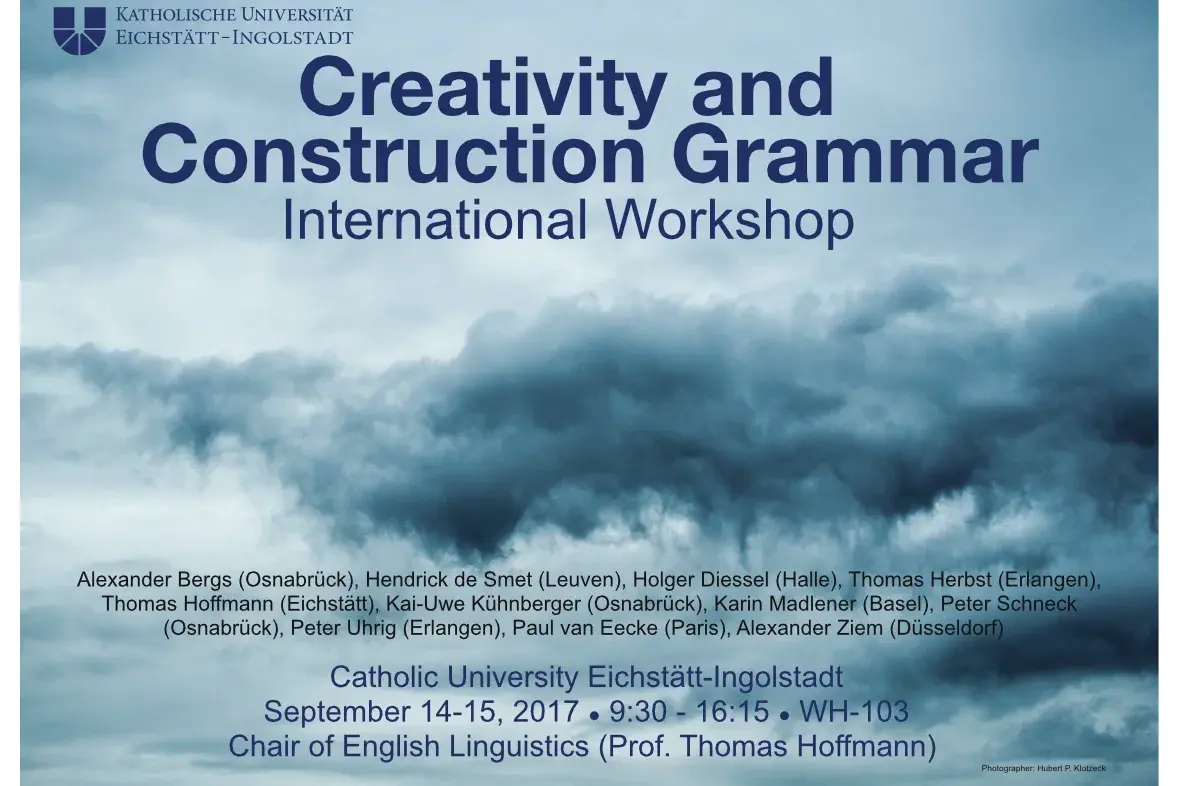Internationaler Workshop "Creativity and Construction Grammar I" (2017)
Veröffentlichung
Aus dem Workshop ist eine Veröffentlichung hervorgegangen. Diese ist zu finden in: Thomas Hoffmann, ed. (2018). Special issue of Zeitschrift für Anglistik und Amerikanistik 66(3).
Allgemeine Informationen
Katholische Universität Eichstätt-Ingolstadt
- 14.-15. September 2017
- 9:30–16:15
- WH-103
Konferenzprogramm
Hier finden Sie das Konferenzprogramm.
Referenten
Alexander Bergs (Osnabrück), Hendrick de Smet (Leuven), Holger Diessel (Jena), Thomas Herbst (Erlangen), Thomas Hoffmann (Eichstätt), Kai-Uwe Kühnberger (Osnabrück), Karin Madlener (Basel), Peter Schneck (Osnabrück), Peter Uhrig (Erlangen), Paul van Eecke (Paris), Alexander Ziem (Düsseldorf)
Abstract
Construction Grammar is a theory of language that claims that the central building blocks of language are constructions - stored pairings of form and meaning. Moreover, instead of a word and rules model, Construction Grammar assumes that there is a lexicon-syntax cline and that constructions can take various positions on that cline ranging from more lexical form-meaning pairings (phonologically fully specified, substantive items such as apple, or the idiomatic the more, the merrier) to more syntactic, schematic constructions (which comprise schematic slots that can be filled creatively, as in the ditransitive construction [NP1 V NP2 NP3] — ‘NP1 causes NP2 to receive NP3 by V-ing’ which licenses structures such as Noam emailed Ray his handout.).In-between these two poles, intermediate structures exist (such as the comparative construction [X BE comparativeADJ ðən Y] — ‘X is more Adj than Y), which contains a substantive element ([ðən]) as well as schematic slots (for the subject X, the form of BE, the comparative adjective and Y; cf. Hoffmann and Trousdale 2013).
During speech production, all Construction Grammar approaches assume that stored substantive and schematic constructs are activated together and combined to yield constructs, i.e. specific tokens. This model of language seems cognitively plausible and has received ample empirical support from first (Diessel 2013) and second language acquisition (Ellis 2013) as well as psycho- (Bencini 2013) and neuro-linguistics (Pulvermüller, Shtyrov and Cappelle 2013). Yet, one issue that has so far received hardly any attention in constructionist work is the issue of creativity: schematic constructions obviously allow speakers to fill the slots creatively. The abstract ditransitive construction, e.g., also licenses ditransitive uses of fairly novel verbs such as to whatsapp as in Jamie's already whatsapped me the white speedos he's going to wear. (Source <http://www.moopy.org.uk/forums/threads/cuba.66115/>). But there are clearly limits to the creative filling of schematic slots. As Croft (2012: 378), for example, points out, not all verbs of refusal can appear with the REFUSE.V-Ditransitive construction, even though they fit the constructions’ semantics:
(1) She refused/denied/*prevented/*disallowed/*forbade him a kiss.
At the same time, there are certain genres that often (consciously) violate constraints on slots to produce a certain effect:
(2) I’m loving it. (McDonalds | cf. https://en.wikipedia.org/wiki/McDonald%27s_advertising)
For Standard British and American English, it was generally considered ungrammatical to use stative verbs such as love in the progressive construction. Yet, not only was the advertising company responsible for (1) able to produce this construct - potential consumers were also able to understand the coerced, affective meaning of this construct.
Now, from advertisement slogans (2,3) over literary language (4), linguistic examples (5) to ’normal’ authentic speech (6), we find a multitude of constructs that seem to be creative in that speaker/writers produced something that goes beyond the constructions stored in their Construct-i-con:
(3) You know when you've been Tango’d. (1994)
(4) The fall (bababadalgharaghtakamminarronnkonnbronntonnerronntuonnthunntro varrhounawnskawntoohoohoordenenthurnuk!) of a once wallstrait oldparr is retaled early in bed and later on life down through all christian minstrelsy. (James Joyce: Finnegans Wake)
(5) Furiously sleep ideas green colorless (Chomsky 1957: 15)
(6) [the more opaque that atmosphere is]C1[the less conductive it is]C2 [the bigger the temperature difference you need to cross it]C3
The aim of the present workshop is to put creativity in all its various aspects on the constructionist agenda. For the workshop, we will invite researchers working on synchronic variation, historical change, first and second language acquisition, computational linguistics as well as psychology, cognitive science and literary studies. Each researcher will be given the chance to present their view of the topic in a short presentation (15-20 mins, followed by 30 mins discussion). A large part of the workshop, however, will then be in an interactive fashion, with all contributors discussing issues and questions relating to creativity, including (but certainly not limited to):
- creative language use in L1- and L2-acquisition
- creativity in language play, humor, different literary (e.g. poems, plays, novels) and nonliterary genres (advertisements, blogs, private dialogues,…)
- interindividual differences: more or less creative language users
- the processing of creative constructions
- constructional constraints on creativity
- the interaction of constructions and Frame Semantics, Conceptual Blending Theory and other cognitive theories in the creation of novel constructs
- …
Selected references
Bencini, Giulia M. L. 2013. Psycholinguistics. In Hoffmann and Trousdale (eds.), 379-96.
Bergs, Alexander 2016. Under Pressure: Norms, Rules, And Coercion in Linguistic Analyses and Literary Readings. In. Michael Birke & Emily Troscianko (eds.), Cognitive Literary Science. Oxford: Oxford University Press, 279-302.
Chomsky, Noam. 1957. Syntactic structures. The Hague: Mouton and Co.
Croft, William. 2012. Verbs: aspect and causal structure. Oxford University Press.
Diessel, Holger. 2013. Construction Grammar and first language acquisition. In Hoffmann and Trousdale (eds.), 347-64.
Ellis, Nick C. 2013. Construction Grammar and second language acquisition. In Hoffmann and Trousdale (eds), 365-78.
Hoffmann, Thomas and Graeme Trousdale, eds. 2013. The Oxford handbook of Construction Grammar. Oxford: Oxford University Press.
Pulvermüller, Friedemann, Yury Shtyrov, and Bert Cappelle. 2013. Brain basis of meaning, words, constructions, and grammar. In Hoffmann and Trousdale (eds.), 397-416.
